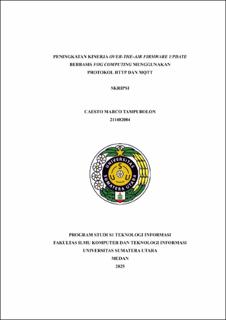| dc.description.abstract | The rapid growth of Internet of Things (IoT) technology has led to billions of interconnected smart devices, making device maintenance—especially firmware updates—a significant challenge. Conventional firmware updates requiring physical access are inefficient, particularly for remote or large-scale deployments. Over-the-Air (OTA) updates offer a wireless solution, but implementations using cloud computing architecture introduce high latency, bandwidth load, and internet dependency. This study evaluates the effectiveness of HTTP and MQTT communication protocols within a fog computing architecture, which brings data processing closer to edge devices. The methodology includes system design, OTA implementation using ThingsBoard Edge on Orange Pi, and Quality of Service (QoS) testing on ESP32 devices. Key parameters measured include latency, throughput, jitter, packet loss, and update duration. Results show that fog computing significantly improves OTA performance compared to cloud-based approaches. In fog architecture, MQTT achieved the fastest average OTA update duration (25.2 s) and lowest latency (81.17 ms) and packet loss (0.18%). HTTP performed better in throughput (256.9 kbps) and jitter stability (18.42 ms). Under cloud architecture, both protocols experienced reduced performance, with MQTT averaging 56.96 s and HTTP 54.81 s for OTA update duration. This study concludes that combining fog computing with MQTT offers the most optimal configuration for OTA firmware updates in resource-constrained IoT environments, enhancing speed, and communication efficiency. | en_US |


